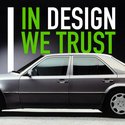
DESIGN WILL CHANGE THE WORLD (AGAIN)
Article by Marco Tonin
The year that has just ended was a year of great upheavals, which affected every aspect of our life, and obviously this also affected the world of design.
Many acquired certainties have failed, new organizational models and new ways of working have emerged: almost everyone agrees that, even when the emergency is over (hopefully soon!) "The world will no longer be what it was before" and this is probably true.
While all this causes understandable anxieties and unknowns for the future, on the other hand the "after", often evoked, can only put the the ability to imagine, that is the design, back at the center of the scene.
And, actually, it won’t be the first time... The world we live in today, in fact, has been largely imagined, designed and built by architects, designers and engineers, those who, taken together, we call "creatives": our lifestyle and consumer habits, fashion, the homes we live in and the places we work, the appliances we use, cars, smartphones... even the way we socialize is largely the result of the fervid mind of creatives.

From the beginning of the last century, uninterruptedly until today, architects, designers, visionaries linked in an invisible thread that goes from Gropius, Mies Van der Rohe, through Marco Zanuso and Ettore Sottsass, up to our contemporaries Steve Jobs and Elon Musk, have created that universe of environments, objects, meanings and relationships with the objects themselves, in which we all live constantly immersed.

This reality, which tends to appear to us as stable, is actually in constant evolution and transformation, and in this sense the travails of the last year have acted as a formidable accelerator of transformation processes that were already underway. My personal opinion is that, in this rapidly changing scenario, as happened in the past, but today more than ever, designers are called into question as privileged actors of change: but to create what? What are the challenges for the next years?
We can try to identify some fundamental themes, in a necessarily non-exhaustive synthesis, with which the designers will be called to measure themselves in the coming years.
A first theme is the progressive fusion between real and virtual, or rather the coexistence of different levels of reality: the possibility of being in different places at the same time, without moving from one's room, the overlapping on the scene of physical elements, virtual reality, holograms, in an increasingly indistinguishable mixture of material and immaterial. The experience side, the software, becomes increasingly central while the physical component, the hardware, becomes essentially irrelevant. This is already true today, for example, for the retail trade, which is increasingly unbalanced on the virtual, but in the future the trend is destined to grow and could involve new ways of traveling, having fun, studying and who knows what else.
A second aspect is the emerging of new consumption models based on sharing, with the paradigm moving from possession of the good, to use of the service: car/bike/… sharing, internet or music streaming, shared offices, are the first examples of this reversal of vision, destined to expand and grow more and more in the coming years. This presupposes the design of new products, designed for the sharing economy since the beginning and not adapted to it, but also the cancellation of many categories of products, replaced by corresponding services (just think of discs / CDs / DVDs, now not more than “vintage” objects). This issue, in sectors that have always been driving forces such as the automotive sector, will have disruptive effects, yet to be explored and difficult even to imagine.
A third theme is sustainability, understood in an environmental sense, but also social and ethical. The adoption of new materials and new technologies, which favor recycling and energy saving, but even more of new behavioral and social models, which bring about an overturning of the overall vision. We are witnessing a change in the focus of environmental sustainability strategies, with the transition from the idea of recycling to that of reuse, and from saving energy to not using energy at all, or even to virtuous energy production practices. Consider, for example, the enormous waste of energy, time, transport, pollution produced, costs associated with the bottling of drinking water (although the bottles are made of recyclable materials). How much more efficient would it be to make safe drinking water available at zero or almost no cost directly near homes (for example at public fountains) to be collected in reusable containers? And in fact, more and more public institutions are becoming aware that, in the long run, the cost of building the necessary infrastructure is much lower than the social, environmental and health cost caused by the pollution that can be eliminated. If we extend the reasoning, in the near future the same model could be applied to the production and sale of food (pasta, oil, cereals, rice, etc.), designing new packaging formats or eliminating the packaging itself, but also to other sectors of commodities or other products.

At the exact center of these great challenges, alongside engineers, scientists, philosophers, politicians, there can only be the design: the ability to synthesize technological competence, social vision and emotion, to overturn logic and put everything into question, makes the designer the perfect protagonist to lead the change.
So the bad news is that we are in big trouble right now; the good one is that, at the center of the change this will produce, there will once again be design and creativity.
Design will change the world (again)!
Images:
W. Gropius - Bauhaus Masters Houses, Gropius House, Dessau (Germany) 1926
R.Piano, R.G. Rogers – Centre Pompidou, Paris (France) 1977
Boeri studio – Bosco Verticale, Milan (Italy) 2014
M. Zanuso e R. Sapper, TS 522 Radio, Brionvega, 1962
Apple iMac G3, 1998
Tesla Cybertruck, 2019
Pompeii Discovery – Virtual Tour – Pompei (Italy) 2019
ZOOX – Autonomous Robotaxi Concept - 2020
Casa dell’acqua - Public drinking water dispenser – Milano Expo (Italy) 2015
Original Unverpackt - No Packaging Store, Berlin (Germany) 2014


